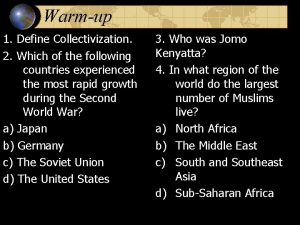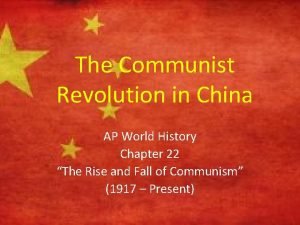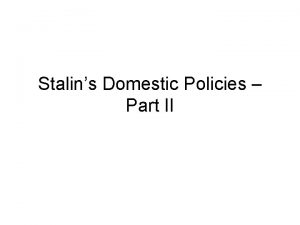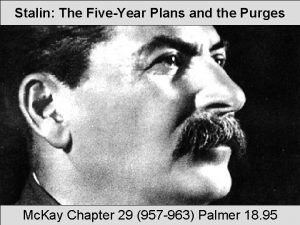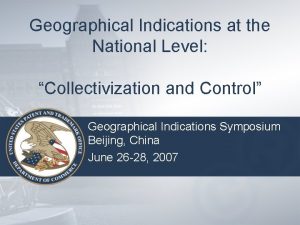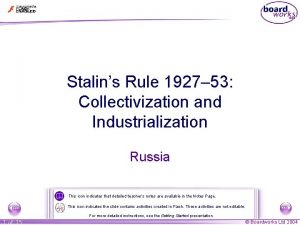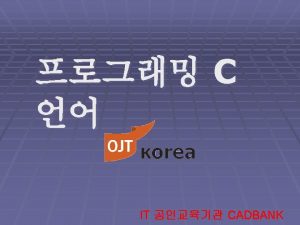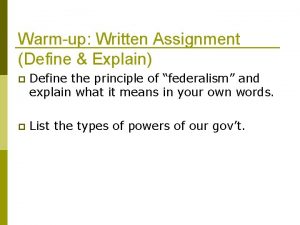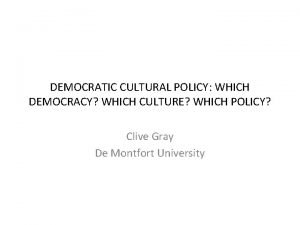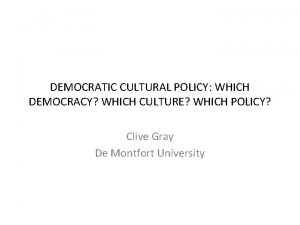Warmup 1 Define Collectivization 2 Which of the




























- Slides: 28

Warm-up 1. Define Collectivization. 2. Which of the following countries experienced the most rapid growth during the Second World War? a) Japan b) Germany c) The Soviet Union d) The United States 3. Who was Jomo Kenyatta? 4. In what region of the world do the largest number of Muslims live? a) North Africa b) The Middle East c) South and Southeast Asia d) Sub-Saharan Africa

1914 -Present Review

The Big Thematic picture theme 1: Patterns and effects of interaction-Pace of interaction grows rapidly Theme 2: Dynamics of changes and continuity-Changes that started in the 19 th century spread rapidly Theme 3: Effects of technology, economics, demographics—from 1 billion to 6 billion in less than 100 years! Theme 4: Systems of social structure and gender structure-Women gained the right to vote, Communism spread under the hope of creating egalitarian societies. Theme 5: Cultural, intellectual, and religious developments-Global culture, Atom bomb, airplanes and rockets, nano technology! It’s all changing so fast. Theme 6: Changes in functions and structures of states. Rise of the nation state after WWII, currently, perhaps the rise of macro-nationalism?

Things to Remember Population increased rapidly as has movement of people. The world has become more and more integrated due to improved communication and transportation technology. Global commerce is the norm. Fundamental religious movements have arisen because of the unease this new fast-paced connected world has fostered. Rise of the Nation-state in all areas of the world. As minority ethnic groups seek to assert their rights, conflicts arise within these states International organizations define the new-world order.

Which of the following policies led to radicalism in both the French Revolution after 1789 and the Russian Revolution after 1917? a) Strikes by factory workers b) War against foreign enemies c) Coming to power of the peasantry d) Creation of a salaried clergy

Answer: B

The Bookends 1914 - outbreak of WWI Weakening of European imperial system Rise of communism with Russian Revolution of 1917

Details- World conflict World War I Great Depression Fascism and totalitarian states World War II Cold War Nationalist movements-Israel, Palestine, Sub-Saharan Africa, Vietnam Revolutions- Russia, China, Mexico, Iran

Anti-colonial movements like the Congress Party in India and the Young Turks agreed on which of the following? a) Their emphasis on purely linguistic nationalism b) The desire to return their societies to an earlier pre-industrial age. c) Their intent to engage in territorial expansion at the expense of their weaker neighbors. d) The need for reform in order to resist European imperialism.

Answer: D

Which of the following is an accurate comparison of the Chinese and the Mexican revolutions of the twentieth century? a) Both promoted imperialism b) Both were supported by Japan c) Both promoted religious education d) Both generated land-redistribution policies

Answer: D

Details- Demography and the Environment Rapid population growth Increased rapidity of Migration. Global diseases- AIDS, SARS, bird flu Rapid Urbanization, especially in the less developed countries Global warming as a result of industrialization Agricultural innovations- Green Revolution and GMO foods

Details- Social changes Changing roles of women in the west- birth control, feminism, women in the workforce. Women involved in revolutions and seen as legally “equal” to men. Conflict between “western” concept of women and traditional concept.

By 1980 most industrialized countries reached a fairly stable population level, but population growth in nonindustrialized countries continued at a very high rate. The most likely explanation for this difference is that: a) Climatic shifts resulting from global warming have caused population decline in the industrialized countries. b) The “green revolution” was rejected by industrialized countries but embraced by non-industrialized countries. c) Pollution in industrialized countries caused a decline in human fertility rates d) Children are a more important source of labor in agricultural than in industrial societies

Answer: D

Mao Zedong and Mohandas Gandhi both appealed to which of the following as a base of support? a) Warlords, wealthy landowners, and merchants b) Westernized elites c) Peasants d) Urban factory workers

Answer: c

Which of the following led to the most dramatic change in the status of Chinese peasant women in the 1940 s and 1950 s? a) b) c) d) The policies of Jieshi (Chiang Kai-shek) that attempted to give rural women more economic opportunities Maoist principles that banned arranged marriages and made women an important part of the Communist women’s movement. The Christian missionaries and their work among peasant families The success of the Japanese during the occupation in making men and women equal participants in the economy

Answer: B

Details- Cultural and Intellectual expressions Art becomes more open, inclusive of cultures, aspects of society Western intellectual thought- especially science and the enlightenment- were highly influential to Asian and African areas. Traditional religious teachings continue to be influential and often form the backbone to anti-imperial activities.

Details- Changing roles of States Challenge to Parliamentary Democracy, WWI, leads to doubt. (21 st century sees strengthening) Radical Ideas Develop, Communism, Fascism Land-based empires absolute rule come under challenge Latin America co-opts ideas from East and West, growth of popular movements African states grow, face similar choices to Latin America

Details: Internationalization of Culture International organizations OPEC WTO Multinational companies Microsoft Mc. Donald’s BP Rock and Roll, Jeans Coka-colazation

Changes and Continuities Change: Nationalism Change: Democracy Change: Rapid Communication Change: Women improved politically and economically Change: Increased industrialization Continuity: Women continue in traditional roles Continuity: Peripheral states continue with subsistence and agricultural economies Continuity: Unrepresentative governments prevalent

Vocab Practice John Maynard Keynes: Franklin Delano Roosevelt: Joseph Stalin: Benito Mussolini: Adolf Hitler: New Economic Policy*: Five-Year Plans*: Collectivization*: Fascism*: National Socialism: : Nuremberg Laws: Muhammad Ali Jinnah: Mohandas K. Gandhi: Mao Zedong: Sun Yatsen: Jomo Kenyatta: Indian National Congress: Chinese Communist Party (CCP): Long March: Guomindang: Pan-Africa: Good neighbor Policy:

Vocab Practice Winston Churchill: Rape of Nanjing*: Axis powers: Blitzkreig: Kamikaze*: The “final solution”: Truman Doctrine*: Marshall Plan*: NATO*: Warsaw Pact*: Nikita Khrushchev: Fidel Castro: Ronald Reagan : Mikhail Gorbachev: Boris Yeltsin: Berlin Wall: Korean War: Containment*: Cuban missile crisis: Perestroika*: Glasnost*:

Vocab Practice Ho Chi Minh: Gamal Abdel Nasser: Kwame Nkrumah: Juan Peron: Jimmy Carter: Nelson Mandela: Suez crisis: Great Leap Forward: Cultural revolution: Palestine Liberation Organization (PLO)*: Iran-Iraq war: Sandinistas: Liberation theology: Apartheid*: Globalization*: Free trade: World Trade Organization (WTO)*: European Union (EU): Organization of petroleum Exporting Countries (OPEC)*: Association of Southeast Asian Nations (ASEAN)*: North American Free Trade Agreement (NAFTA)*: HIV/AIDS:

No Warm-up - All you need out is a pencil or pen. Unit 1 Unit 2 Unit 3 Unit 4 Unit 5 Unit 6 8000 -600 bce-600 ce 600 -1450 -1750 -1900 -present
 Define collectivization
Define collectivization Define:warmup
Define:warmup Collectivization ap world history
Collectivization ap world history Collectivization
Collectivization Collectivization
Collectivization Collectivization
Collectivization Sec 3 history
Sec 3 history Warmup ratio
Warmup ratio Warmup 65
Warmup 65 Gmass warmup
Gmass warmup Status vs class
Status vs class Pyramid warmup
Pyramid warmup Warm rhyming words
Warm rhyming words Multiplying with exponents
Multiplying with exponents Java warmup
Java warmup Pathos story
Pathos story Tom schwartz tinman
Tom schwartz tinman 65 mins
65 mins Warmup end
Warmup end Hình ảnh bộ gõ cơ thể búng tay
Hình ảnh bộ gõ cơ thể búng tay Ng-html
Ng-html Bổ thể
Bổ thể Tỉ lệ cơ thể trẻ em
Tỉ lệ cơ thể trẻ em Chó sói
Chó sói Tư thế worm breton
Tư thế worm breton Hát lên người ơi alleluia
Hát lên người ơi alleluia Kể tên các môn thể thao
Kể tên các môn thể thao Thế nào là hệ số cao nhất
Thế nào là hệ số cao nhất Các châu lục và đại dương trên thế giới
Các châu lục và đại dương trên thế giới
